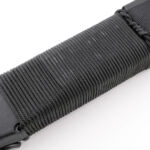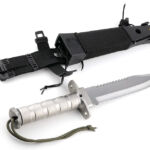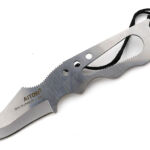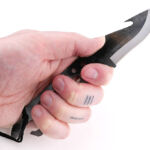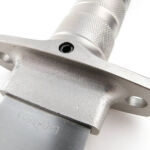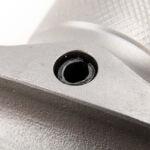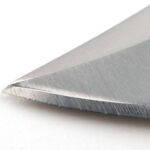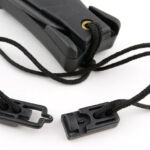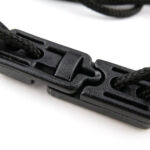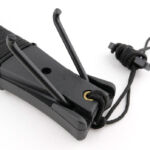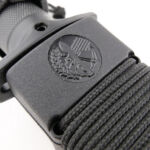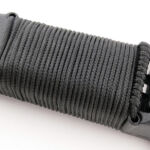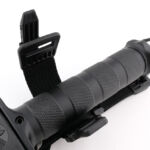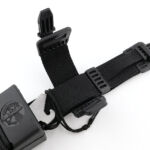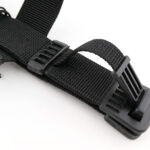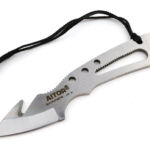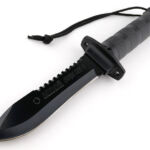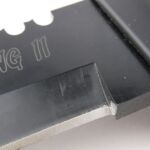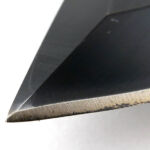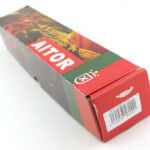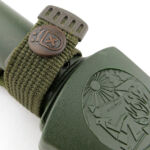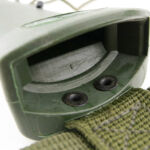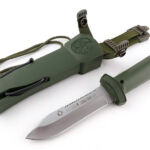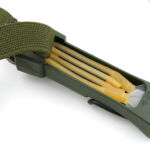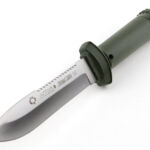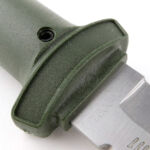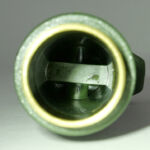Join me in an epic super-detailed two-part review of the AITOR Jungle King knife series, the Jungle King 1, 2 and 3. For me, this style of knife focuses on the fun in outdoor knife use that is so often overlooked due to the fashion to dismiss any knife if it doesn’t have a full tang and the latest super-steel. Let’s allow ourselves the simple enjoyment of using different knives and with the Jungle King Series, Aitor have packed them with interesting, fun and useful features.
This epic review of the Aitor Jungle King Series knives is has so much detail I’ve had to split it into two parts. In this, the first part, you can see all the design details and features of each model – a technical presentation. Part two will then explore using the plethora of functions Aitor give you.
The Jungle King I is one of the most famous knives on the market, and as we know it now, was released in 1985 following the huge increase in demand for this style of knife, first made popular due to the movie ‘First Blood’ and its sequels.
It was not long before the Jungle King II joined its bigger brother, and then went on to be (probably) the most copied design ever for this type of survival knife. It is these inferior copies that gave the style of knife a bad name. The Aitor Jungle King II is not the same, as the hollow handle is made of metal and is built for heavy use. Each blade is Rockwell hardness tested during production, proudly shown on the blade in the “Hardness Control” circle engraved to highlight this quality control check.
The Jungle King III is the little brother of the Jungle King knife series. Agile and fast, its design is versatile and functional make it a very capable tool. The Jungle King III joins the family and gives you a choice of size and weight.
Jungle King knives have been issued as part of basic military equipment by some armed forces, including the Special Operations Unit of Marine Spanish Armed Forces. Over the years, the Jungle King has been considered by many experts as the best survival knife in the world, pioneering and unique, being one of the best in its category. Its design, versatility and functionality make it very useful for survival.

The entire Jungle King Series (at the time of writing) is represented in this review, so we’ll be looking at the Jungle King 1, 2 and 3 (or I, II and III).

Jungle King 1 – What’s in the box?:

The Jungle King arrives in a cardboard box, simply the sheathed knife and nothing else. I’ve included an initial indication of size as here it is held in my XL glove size hand.
A good look round the Jungle King 1’s Sheath – Things to look out for here are:
For this gallery we are looking at just the sheath, not any of the extras in it. A simple cord leg strap with snap together fastener is included. Then, sorry, but I do need to use the word ‘iconic’ , we have the iconic folding slingshot arms. The main body of the sheath is wrapped in cord. The cord serves two purposes, first is that it will be a seriously useful survival item, the other is that while stored on the sheath is covers up the sheath mounted sharpening stone which you can see peeking out as I pushed the cord aside slightly.
For the retention strap Aitor use a quick-release toggle type of fastener, more commonly used on military MOLLE pouches. Reliable and strong and unlike a press stud it can’t loosen over time. Similarly, the belt loop also has the quick-release toggle to open and allow it to be fitted to a belt without undoing the belt.
A good look round the Jungle King 1’s Kit – Things to look out for here are:
We saw a hint of this in the previous gallery; tucked into the sheath is a slide-out tray, and a full tang secondary knife / multi-tool.
Held within the tray are the slingshot rubbers, a small glass vial, and a magnesium block with firesteel. The back of the tray has a cut-out to house the secondary knife, plus a signaling mirror. Also on the tray are some molded in reminders for signaling protocols.
So, we actually have a whole other knife, the Aitor Skinner JK1, a full tang multi-purpose blade, with gut hook, spanner, bottle / can opener, and flat head screwdriver. Plenty of holes are provided to lash this to a pole as a spear point.
For the details of the Jungle King I hollow handle kit, please see the feature length video.
A good look round the Jungle King 1 Knife – Things to look out for here are:
Onto the Jungle King Knife itself. Big and full-metal construction makes this a beast. The handle is cast from the same steel as the blade, and the tailcap is non-magnetic stainless steel, so this is full stainless steel construction. As well as being epoxied into the handle, the blade tang has a large roll-pin driven through it to make the join very strong, while the front part of the handle is extended to further support the blade to handle join.
A hollow grind is used for the primary bevel, and the Jungle King features a saw-back using Aitor’s unique pattern. Don’t miss the fact that during production each blade is individually HRC tested and this test indentation is identified with an engraving on the blade to highlight it. The sweeping swedge finishes off the classic blade shape.
Unscrewing the tail-cap reveals the survival capsule kit in the handle, and inside the tail-cap is a button compass. There is an o-ring to keep the handle compartment water tight, and inside the handle a spring is used to stop the capsule rattling, and helpfully push it out slightly as you open the handle. For the details of the Jungle King I hollow handle kit, please see the feature length video.
Jungle King 2 – What’s in the box?:

The Jungle King 2 arrives in a cardboard box, simply the sheathed knife and nothing else.
A good look round the Jungle King 2’s Sheath – Things to look out for here are:
For this gallery we are looking at just the sheath, not any of the extras in it. As with the Jungle King I, a simple cord leg strap with snap together fastener is included. Then, again, we have the iconic folding slingshot arms. The main body of the sheath is wrapped in cord. The cord serves two purposes, first is that it will be a seriously useful survival item, the other is that while stored on the sheath it covers up the sheath mounted sharpening stone, which you can see peeking out as I pushed the cord aside slightly.
As with the Jungle King 1, for the Jungle King 2’s retention strap, Aitor use a quick-release toggle type of fastener, more commonly used on military MOLLE pouches. Reliable and strong and unlike a press stud it can’t loosen over time. Similarly, the belt loop also has the quick-release toggle to open and allow it to be fitted to a belt without undoing the belt.
A good look round the Jungle King 2’s Kit – Things to look out for here are:
Tucked into the sheath is a slide out tray, and a just as with the Jungle King 1, includes a full tang secondary knife / multi-tool.
Held within the tray are just the slingshot rubbers as there is less space inside the Jungle King 2’s sheath. The back of the tray has a cut-out to house the secondary knife, plus a signaling mirror. Also on the tray are some molded in reminders for signaling protocols.
So we do have a whole other knife, the Aitor Skinner JKII, a full tang multi-purpose blade, with gut hook, spanner, bottle / can opener, and flat head screwdriver. Plenty of holes are provided to lash this to a pole as a spear point.
A good look round the Jungle King 2 Knife – Things to look out for here are:
Onto the Jungle King 2 Knife itself. As with the Jungle King 1, the handle is cast from the same steel as the blade, and the tailcap is non-magnetic stainless steel, so this is full stainless steel construction. As well as being epoxied the blade tang has a large roll-pin driven through it to make the join very strong while the front part of the handle is extended to further support the blade to handle join.
A hollow grind is used for the primary bevel, and the knife features a saw back using Aitor’s unique pattern. Don’t miss the fact that during production each blade is individually HRC tested and this test indentation is identified with an engraving on the blade to highlight it. The sweeping swedge finished off the classic spear-point blade shape.
Unscrewing the tail-cap reveals the survival capsule kit in the handle and inside the tail-cap is a button compass. There is an o-ring to keep the handle compartment water tight, and inside the handle a spring is used to stop the capsule rattling, and push it out slightly as you open the handle.
A good look round the Aitor Jungle King 2 Survival Capsule – Things to look out for here are:
The survival capsule…usually this is opened straight away and then quickly lost, or just never touched. Of course the idea is to pack in as many useful things as possible, which might help you or make some survival tasks easier. Aitor’s survival capsule contains two standard plasters, a sterile No. 23 scalpel blade, tweezers, fire-steel, two small safety pins, two sewing needles, some thread, plus a fishing kit consisting of three pre-tied hooks, a longer piece of line and three split shot. (Plus, don’t forget that they can sometimes oddly useful, the two staples that closed the bag containing the fishing kit.)
All these things are better to have and not need, than to need and not have.
Jungle King 3 – What’s in the box?:

In keeping with the rest of the series, the Jungle King 3 arrives in a cardboard box, simply the sheathed knife and nothing else.
A good look round the Jungle King 3’s Sheath – Things to look out for here are:
Being a simpler, smaller, lighter design for a younger user, the Jungle King 3 sheath keeps some of the character, but has less detail.
A simple cord leg-tie lace is included and needs to be knotted to use. Despite the simplification, Aitor have still included the iconic folding slingshot arms. The back of the sheath has a strip of webbing running along it (we’ll come back to this).
For the Jungle King 3, the retention strap uses a press stud and the belt loop has a quick-release toggle to open and allow it to be fitted to a belt without undoing the belt.
A good look round the Jungle King 3’s Kit – Things to look out for here are:
For the smallest in the Jungle King series, the sheath ‘kit’ is not really a kit, it comprises only the slingshot bands, tucked behind that webbing strip on the back of the sheath.
A good look round the Jungle King 3 Knife – Things to look out for here are:
Onto the Jungle King 3 Knife itself. Stepping away from the all metal construction, instead the handle is made from fibreglass-reinforced polyamide. As well as being epoxied into the handle, the blade tang has a roll-pin driven through it to strengthen the join.
A hollow grind is used for the primary bevel, and the spine has a double-bevel serrated edge. The Jungle King 3 is also individually HRC tested and this test indentation is identified with an engraving on the blade to highlight it.
For the Jungle King 3, the compass is always visible in the end of the tail-cap (although you do need to remove it to use it as the blade affects the compass direction). Unscrewing the tail-cap reveals the brass thread inserts used to ensure the threads last well. Inside the handle is a slim survival capsule kit plus a combination tool designed to fit round the capsule. This tool has a can/bottle opener, pry tool and flat head screwdriver.
The Blade and Handle – Detailed Measurements:
For full details of the tests and measurements carried out and an explanation of the results, see the page – Knife Technical Testing – How It’s Done.
The blade is made from MoVa / DIN 1.4116 which is identical to X50CrMOV15 steel.

The Factory edge up close:
Followers of Tactical Reviews will know my views on factory edges, but to recap:
Anyone using a knife will need to sharpen it. That first factory edge is just like the first tank of fuel that a new car comes with (or first charge of the battery).
A good factory edge is a ‘nice to have’ but not a ‘make or break’ for a good knife, as you will be putting your own edge onto it soon enough.
The factory edge does however indicate the care a knife maker has put into the final finish.
It is for this reason Tactical Reviews measures factory edge sharpness and specifications, and includes this information in the detailed technical testing.
As a further look at the factory edge, this section has been added to include some high magnification photos of the factory edges.
Remembering all these factory edges were around 500 BESS, which is not sufficient for my testing, they look quite good under magnification, but all needed to be reprofiled. The Jungle King 2 was the best of the three from the factory, but all these knives were utterly transformed by a good edge.
Jungle King 1
Jungle King 2
Jungle King 3
Part 1 ends here with the review videos included below. See Part 2 for all the practical testing and insights plus a unique insight into the madness of UK knife law.
Review Videos
Starting with a short format sixty second review of the Jungle King 1:
Starting with a short format sixty second review of the Jungle King 2:
Starting with a short format sixty second review of the Jungle King 3:
Onto a full video review covering many more details of all three:
















